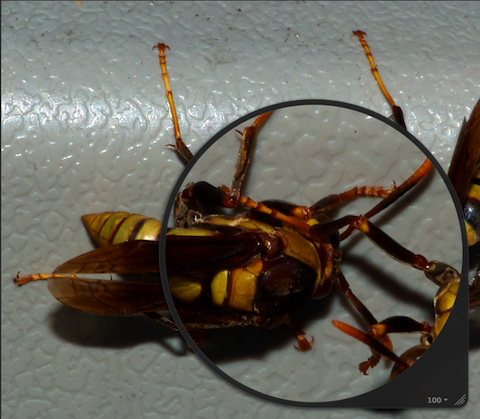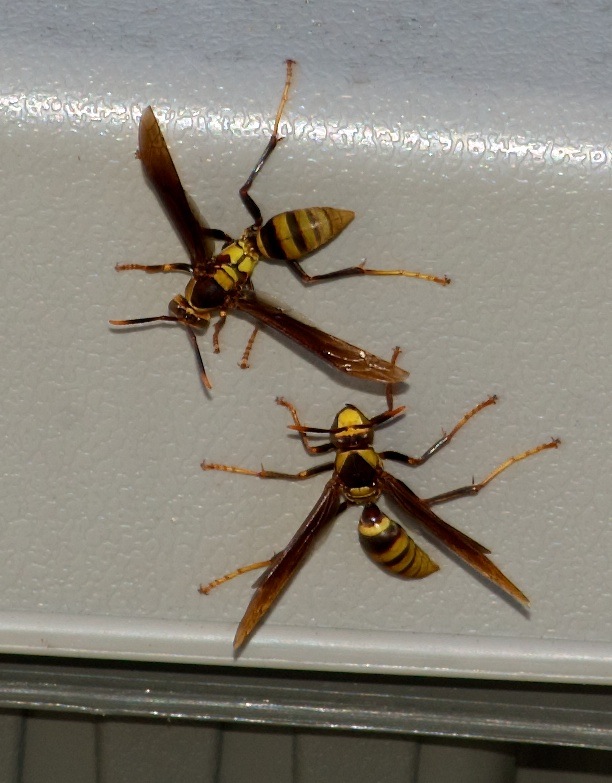Earlier this week I witnessed some insect behavior with which I was previously unfamiliar. (To be fair, I am unfamiliar with, to make a conservative estimate, most insect behavior.) A pair of wasps of the species Polistes major were, to put it simply, crowding each other on our deck box. Sometimes they would face each other, sometimes near, sometimes a bit farther apart. It lasted for hours. I discovered them around 8 a.m. while playing outside with the boys; it was still going on shortly before noon. Right around noon, and I’m not sure exactly when, one of the wasps disappeared. Here’s a little photo gallery of the incident.
polistes_major_dance_20121108-1
This was no high-speed waggle dance like you’ve heard about in a honeybee hive; this was a good old-fashioned slow-motion staredown. For the most part it looked like one wasp was clearly dominant over the other; in one of the shots you can see the submissive wasp tucking her head into the surface of the deck box while the dominant one is crawling over her:

Of course, to the human eye, particularly an untrained one like mine, there’s no way to tell why the wasp on the left is submitting to the wasp on the right; they appear almost identical to me. But the wasps appear to have sorted out, even if it took a little while.
Presumably the wasp that remains was the victor; I’ve only seen one wasp at a time since noon on Thursday. The one thing that worries me is that the most frequent sighting site is inside my deck box, which is where we store our pool and back yard toys. I don’t want an enraged wasp colony in there when the kids open the box to take out a pool noodle, so I’m going to have to keep a close eye on this situation.


I found this page doing a search for Polistes major. I initially thought this was some sort of courtship behavior, but you can sex paper wasps by counting abdominal segments (males = 7, females = 6) and these both appear to be females. So I contacted a paper wasp biologist at the Carnegie Museum of Natural History, and included a link to this post. He replied, “Apparently, vespid female reproductives [i.e., breeding females] do this kind of posturing as a way to establish dominance. [Another hymenopterist] and I disagree as to what it means. She thinks it is blunt hostility, I think it is ritualized. In my view, this shows that the loser may well stick around and cooperate with the winner, otherwise why not bite off her antennae and sting her to death. Rituals like this mean they DON’T want to use all their force. Anyway, what you have sent shows that Polistes major does it too, and I don’t know any previous report from Polistes that is so easy to interpret.”
9/31/15 I am so glad to get some info on these wasps. Earlier in the summer, here in Lake Wales, FL, I had a these wasps build a paper nest in a small grapevine I planted plus I had a nest on the eaves in front of my house and one on the eaves of the back of my house. I kept an eye on the grapevine bunch for the fun of it. They have not been aggressive even when I mess with the wasps. It’s a fairly small nest with maybe 10-20 wasps. The first nest came off after maybe a couple of months, for some reason, but a new nest was forming on the same grapevine. A wasp from the backyard nest in the eaves flew down and deliberately stung me, without any provocation that I know of. I took the eaves nests down with a broom. Where those wasps went I don’t know.
As for the second nest, I look at it almost daily. I haven’t really seen anything in those holes in the nest. Although the wasps cover the nest pretty good. They may be covering the holes with the babies. So many wasps for such a little nest! After reading a bit about polistes major I will now have to start paying more attention. How do I tell which one’s a male? How do I recognize the queen? Are there females fighting? When are the babies born? How long before they hatch? I have not noticed any enlargement of the nest. How many wasps to a nest? Which ones are dating? The males have a separate nest? If so, how far away? Why would they need a nest? The adults don’t have shelter in a nest? When it rains it appears they just get wet. How many female babies and male babies to a nest? How long do male and female wasps live? Do wasps visit other wasp nests? This is all so interesting but I’m not very good delving into things like this without guidance.
Two things, one- a neighbor was sitting in a chair on his back and complained about wasp nests under the roof of his porch. He mentioned he was going to spray to kill them. I mentioned I had a wasp nest on my little grape vine. The man’s wife said “Jim, when you spray those on our porch go spray her’s too.” I guess she didn’t understand that I deliberately left that wasps nest because they are nature. I explained it to her. I know they thought I was nuts.
Two- One of these wasps was standing on a branch of the grapevine in the sunlight. It looked like a piece of magnificent artwork. The sun was picked up in it’s sheer wings and with the color of the body it looked like a wasp made of bronze.
Thanks for sharing your story, Kristen. I’ve often found it difficult to convince people that most wasps aren’t dangerous unless you want them to be. Big, aggressive species certainly can be, but if you take the time to get a proper ID (take pictures and get them identified by an expert) you can find out whether they can be lived with or need to be removed.
To find out more about wasps, I highly recommend reading Eric Grissell’s Bees, Wasps, and Ants: The Indispensable Role of Hymenoptera in Gardens. Lots of good information in there, and a good starting point if you want to get your questions answered. (Congratulations on posing so many interesting questions–too many for me to address in this brief forum!)
Good luck in your investigations!